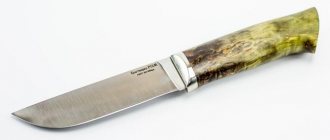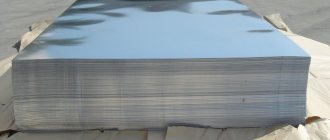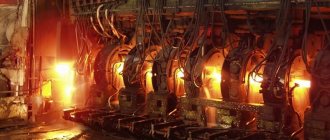Characteristics of steel grade 5sp
St5sp - Structural carbon steel of ordinary quality, limited weldability, welding is carried out without heating and without subsequent heat treatment, welding methods: manual arc welding, automatic submerged arc welding and gas protection, ESW, KTS without restrictions. According to NAKS Group: M07 (W07). Electrodes UONI-13/55U. For thicknesses greater than 35 millimeters, heating and subsequent heat treatment are recommended; it is not prone to flake sensitivity and there is no tendency to temper brittleness. Machinability by cutting in the hot-rolled state at HB 158 σB = 630 MPa Kυ hard alloy. = 1.2 and Kυ b.st. = 1.2, has found its application in the production of parts for riveted structures; bolts, nuts, handles, rods, bushings, rollers, wedges, rods, sprockets, tube sheets, flanges and other parts operating at temperatures from 0 to 425 degrees, production of At500C class fittings; St5sp steel has relatively high toughness and ductility, slightly higher than St5ps steel. Forging at temperatures from 1260 to 750 0C, cooling is carried out in air. St5sp steel is not prone to temper brittleness and is magnetic.
Interpretation of steel grade 5sp
Decoding of steel: The letter at the beginning indicates a group of steel which defines the criteria for the ultimate strength for the chemical composition; if there is no letter, then such steel belongs to group A, and is supplied to consumers based on mechanical properties (such steel may have a high sulfur or phosphorus content). Letters St. indicate that the steel is of ordinary quality, although most steels are high quality. The numbers from 0 to 6 are the conventional brand number depending on the chemical composition and mechanical properties. Typically, the higher the number, the more carbon and the greater the strength. In our case, 5 indicates the carbon content in the alloy is 0.28–0.37%. The letters after the brand number indicate the degree of deoxidation: cn - calm. In terms of price, calm steels have become more expensive than semi-calm and boiling steels. Mild steel is steel obtained as a result of deoxidation. It is obtained by deoxidation with aluminum, manganese and silicon. The level of oxygen in it is so reduced that during metal processing no reaction occurs between carbon and oxygen, and the presence of non-metallic slags and their inclusion is reduced to a minimum. Calm steel has a dense structure and good mechanical properties. It is less prone to negative reactions to welding heat and to aging. The features of a homogeneous microstructure give the alloy maximum corrosion resistance and ductility.
Steel 5, steel grade St 5 its characteristics and description
Steel grade: St. 5
No. GOST 380-50
Replacement steel grade: Mst. 5
Type of heat treatment and steel hardness 5: Without heat treatment
Recommended area of application for steel 5: Welded parts, lightly loaded parts that are not subject to wear during operation: handles, rods, etc.
Note: Welded products with complex configurations or products with a significant number of welds are annealed to relieve stress arising during the welding process.
Brinell hardness: Hb kg/mm: 156-197
Rough processing with high-speed tools (turning, drilling, milling, etc.):
- Cutting speed Kv: 1.3
- Machine productivity Kpr: 1.15
High-speed machining with carbide tools (turning and milling):
- Cutting speed Kv: 1.20
- Machine productivity Kpr: 1.1
Fine machining with high-speed tools:
- Cutting speed Kv: 1.0
- Machine performance Kpr: 1.0
- Getting a good surface finish: difficult
Note: the main criteria for machinability are cutting speed and machine performance
Mechanical properties of steel Art. 5:
- ?in kg/mm2: 50-53; 54-57; 58-62;
- ?t kg/mm2: >28
- ? kg/mm2: >17; >16; >15;
- ? %: >21; >20; >19;
- ?k kgm/cm2: —
- Hardness Hb: <170;
Characteristics of steel Art. 5 and its meanings: Low carbon steel of ordinary quality. Available only according to mechanical properties. It welds well, is stamped in cold and hot conditions, and is drawn. It is used without heat treatment for welded and stamped parts: machine troughs, tanks, covers, casings, gaskets, etc. Steel is produced in the form of long and shaped rolled products, strips and sheets.
Chemical composition of steel 5 in%:
- C (carbon): 0.28-0.37;
- Mn (manganese): 0.50-0.80;
- Si (silicon): 0.17-0.35;
- S (sulphur): <0.055;
- P (phosphorus): <0.050
omashinostroenie.com
Supply St5sp
Supplied in the form of long products, including shaped steel according to GOST 2590-88 Hot-rolled round steel, GOST 2591-88 Hot-rolled square steel, GOST 8239-89 Hot-rolled steel I-beams, GOST 19771-93 Equal-flange bent steel angles, GOST 19772 -93 Bent steel angles, unequal flange, GOST 8278-83 Bent steel channels, equal flange, GOST 8281-80 Bent steel channels, unequal flange, GOST 8283-93 Bent steel trough equal flange profiles, GOST 380-94 Carbon steel of ordinary quality, GOST 8509-93 Steel corners hot-rolled equal flange, GOST 8510-86 Hot-rolled steel angles unequal flange, GOST 8240-97 Hot-rolled steel channels, GOST 535-88 Rolled bars and shaped carbon steel of ordinary quality, GOST 2879-88 Rolled hot-rolled hexagonal steel, GOST 19903-2015 Rolled sheets hot rolled , GOST 19904-90 Cold-rolled sheets, GOST 16523-97 Rolled thin sheets of high-quality and ordinary quality carbon steel for general purpose, GOST 503-81 Cold-rolled low-carbon steel strip, GOST 103-76 Hot-rolled steel strip, GOST 82-70 Hot-rolled steel broadband universal, GOST 3282-74 General purpose low-carbon steel wire, GOST 17305-71 Carbon structural steel wire, GOST 10705-80 Electric-welded steel pipes, GOST 10706-76 Straight-seam electric-welded steel pipes, GOST 3262-75 Steel water-gas pipes.
| Metal forming. Forgings | GOST 8479-70; |
| Classification, nomenclature and general norms | GOST 380-2005; |
| Long and shaped rolled products | GOST 10884-94; GOST 535-2005; GOST 5422-73; GOST 5781-82; GOST 8509-93; GOST 8510-86; GOST 8240-97; GOST 2879-2006; GOST 2591-2006; GOST 2590-2006; GOST 11474-76; GOST 8320.0-83; GOST 9234-74; GOST 17152-89; GOST 18662-83; GOST 19240-73; GOST 19425-74; GOST 8239-89; |
| Sheets and strips | GOST 14918-80; GOST 103-2006; GOST 14637-89; GOST 16523-97; GOST 19903-74; |
| Ribbons | GOST 6009-74; GOST 3560-73; |
| Rails. Overlays. Linings. Crutches | GOST 12135-75; GOST 8194-75; GOST 7056-77; GOST 3280-84; |
| Steel pipes and connecting parts for them | GOST 8731-87; GOST 8732-78; GOST 9567-75; GOST 3262-75; GOST 53383-2009; |
Types of unalloyed carbon steels by carbon content
Low carbon with a C content of no more than 0.25%
Most of these products are produced in the form of cold-rolled or annealed sheets and strips. Properties, and therefore the scope of its application, depend on the percentage of components:
- Up to 0.1% C, Mn less than 0.4%. High ability to hot deformation and cold drawing. The materials are in demand in the production of wire, very thin sheets used in the manufacture of containers, and also for the manufacture of car bodies.
- C 0.1-0.25%. The ability to deform is lower than that of the group described above, but the hardness and strength are higher. Often these grades are in demand for the production of parts with a cemented surface layer. The carburization process produces a wear-resistant surface layer combined with a tough core. This is true for shafts and gears.
- C at 0.25%, Mn and Al – up to 1.5%. They have high viscosity. Aluminum is not added to metals intended for stamping, forging, the production of seamless tubes and sheets for boilers.
- C at 0.15%, Mn - up to 1.2%, Pb up to 0.3% or without it, minimum amount of Si. This group is used in mass production on automatic lines of parts not intended to withstand severe mechanical and temperature loads. For products with high requirements for ductility, toughness, and corrosion resistance, alloys are not used.
Medium carbon with C0.2-0.6%
The manganese content is usually in the range of 0.6-1.65%. They are used in the production of products intended for use under high loads. They are usually produced calm. They are strengthened by cold hardening or heat treatment. All steels in this group can be forged. These metal products are widely used in mechanical engineering. Grades with a high carbon content (0.4-0.6%) are in demand in the production of railway rails, wheels and car axles.
High carbon – 0.6-2.0%
Increasing the amount of carbon to 1% leads to an increase in strength and hardness with a gradual decrease in the yield strength and plasticity. When the percentage of C increases above 1%, the formation of a coarse network of secondary martensite begins, leading to a decrease in the strength of the material. Therefore, steels with a C content of more than 1.3% are practically not produced.
High-carbon grades have a high manufacturing cost, have low ductility, and are difficult to weld. The scope of application of this group is quite limited - the production of cutting tools, including those intended for earthmoving and agricultural machinery, and the production of high-strength wire.
Mechanical properties St5sp
Mechanical properties of steel St5sp according to GOST 535-2005 regulations is sold in the form of hot-rolled steel with a cross section of up to 10 mm, from 10 to 20 mm, from 20 to 40 mm, from over 40 mm to 100 mm, and also from more than 100 mm. Rolled thickness: 10-20 mm, yield strength: > 285 MPa, tensile strength: 490-630 MPa, relative elongation: >20%, bending until the sides are parallel: d=3a. Rolled thickness: 20-40 mm, yield strength: > 275 MPa, tensile strength: 490-630 MPa, relative elongation: > 19%, bending until the sides are parallel: d=4a. Rolled thickness: 40-100 mm, yield strength: > 265 MPa, tensile strength: 490-630 MPa, relative elongation: >17%, bending until the sides are parallel: d=4a. Rolled thickness: > 100 mm, yield strength: > 255 MPa, tensile strength: 490-630 MPa, relative elongation: > 17%, bending until the sides are parallel: d=4a. Rolled thickness: < 10 mm, yield strength: > 295 MPa, tensile strength: 490-630 MPa, relative elongation: > 20%, bending until the sides are parallel: d=3a
| Type of rental | Size | Eg. | sв | sT | d5 | y | KCU | Heat treatment |
| — | mm | — | MPa | MPa | % | % | kJ/m2 | — |
| Pipes, GOST 8731-87 | 490 | 274 | 17 | |||||
| Rolled goods, GOST 535-2005 | 490-630 | 255-295 | 17-20 | |||||
| Thick sheet, GOST 14637-89 | 490-630 | 255-285 | 17-20 | |||||
| Fittings, GOST 5781-82 | 490 | 295 | 19 |
St5Gps | "ConcordMetal"
This page shows the technical, mechanical and other properties, as well as the characteristics of steel grade St5Gps.
Classification of material and application of the St5Gps brand
Brand: St5Gps Material classification: Structural carbon steel of ordinary quality Application: I-beams, channels, angle steel
Chemical composition of the St5Gps material in percentage terms
| C | Si | Mn | Ni | S | P | Cr | N | Cu | As |
| 0.22 — 0.3 | up to 0.15 | 0.8 — 1.2 | up to 0.3 | up to 0.05 | up to 0.04 | up to 0.3 | up to 0.008 | up to 0.3 | up to 0.08 |
Mechanical properties of St5Gps at a temperature of 20oC
| Assortment | Size | Eg. | sв | sT | d5 | y | KCU | Thermal change |
| — | mm | — | MPa | MPa | % | % | kJ/m2 | — |
| Rolled goods, GOST 535-2005 | 450-590 | 255-285 | 17-20 | |||||
| Thick sheet, GOST 14637-89 | 450-590 | 255-285 | 17-20 |
Explanation of symbols, abbreviations, parameters
| Mechanical properties : | |
| sв | — Short-term strength limit, [MPa] |
| sT | — Proportional limit (yield strength for permanent deformation), [MPa] |
| d5 | — Elongation at break, [%] |
| y | — Relative narrowing, [%] |
| KCU | — Impact strength, [kJ/m2] |
| HB | — Brinell hardness, [MPa] |
| Physical properties: | |
| T | — Temperature at which these properties were obtained, [Deg] |
| E | — Modulus of elasticity of the first kind, [MPa] |
| a | — Coefficient of thermal (linear) expansion (range 20o— T), [1/degree] |
| l | — Thermal conductivity coefficient (heat capacity of the material), [W/(m deg)] |
| r | — Material density, [kg/m3] |
| C | — Specific heat capacity of the material (range 20o—T), [J/(kg deg)] |
| R | — Electrical resistivity, [Ohm m] |
Other brands in this category:
Please note that this information about the St5Gps brand is provided for informational purposes. The parameters, properties and composition of the actual St5Gps brand material may differ from the values given on this page. More detailed information about the St5Gps brand can be found on the information resource Brand of steel and alloys. You can check with our managers for information about the availability, delivery times and cost of materials. If you find inaccuracies in the description of materials or errors found, please inform the site administrators using the feedback form. Thanks in advance for your cooperation!
www.c-met.ru
Foreign analogues of 5sp grade steel
| USA | A57050, A57250, K02305, K02507 |
| Germany | 1.0050, E295, Fe490-2, St50-2 |
| Japan | SS490, SS50 |
| France | A50-2, E295 |
| England | 4360-50B, 50B, E295, Fe490-2FN |
| European Union | E295, E335, Fe50-2FN, Fe50-3FN |
| Italy | E295, Fe490 |
| Belgium | FE490-2FN |
| Spain | A490-2, E295, Fe490-2FN |
| China | Q275 |
| Sweden | 1550, 2172 |
| Bulgaria | ASt5, E295, WSt5ps, WSt5sp |
| Hungary | E295, Fe490-2 |
| Poland | MSt5, St5 |
| Romania | OL50.1 |
| Czech | 11500 |
| Austria | St50F |
| Switzerland | St50-2 |
| South Korea | SS490 |
Buy 5SP steel in Moscow and the Moscow region
5SP steel is widely used in various fields of industry, used in mechanical engineering, involved in the manufacturing industry, covers a wide range of construction, shipbuilding, and is partially used in aircraft production and many other areas of industry. There are a large number of steel grades, a huge part of the alloys are made to order, and those steel grades that are in great demand are partially stored for regular customers. The Metallpro company carries out wholesale and retail sales on the territory of the Russian Federation; 5SP steel is partly in our warehouse in the form of rolled metal products, and partly we ship directly from the metallurgical plant. With constant demand, we are ready to offer mutually beneficial cooperation, delivery directly from the factory by carriage standards, as well as by motor vehicles. You can buy 5SP steel in Moscow and the Moscow region at a favorable price from the Metallpro Trading Company under a mutually beneficial contract for a long partnership period.
Classification of carbon steels by degree of deoxidation
Calm
Such alloys have the most uniform structure. For deoxidation, aluminum, ferrosilicon and ferromanganese are used, which almost completely remove the gases present in the melt. The combination of the almost complete absence of gases with a fine-grained structure due to the presence of residual aluminum ensures good quality of the metal. These grades are suitable for the manufacture of parts, products and structures for critical purposes. The main disadvantage is the high cost.
Boiling
This is the cheapest and least quality group. Due to the use of a minimal amount of additives for deoxidation, dissolved gases are present in the material, which cause heterogeneity in the structure, chemical composition, and therefore mechanical properties. Such metals have poor weldability, since due to the presence of gases there is a high probability of cracks forming at the seams.
Semi-calm
The group occupies an intermediate position in terms of cost and characteristics. Much fewer gas bubbles form in the casting compared to boiling steels. When rolling, internal defects in the bulk are eliminated. Such materials are often used as structural alloys.
Price for steel 5SP
The favorable price for the 5SP steel grade is explained by the presence of a competitive environment, low markups and loading from leading metallurgical plants directly, sometimes bypassing storage at transshipment points. Metalpro company bears full responsibility for the chemical composition of the supplied products and guarantees the quality of delivery. The cost of 5SP steel in warehouses in Moscow and the Moscow region is determined by the costs of warehousing and logistics. The Metallpro Company can also supply 5SP steel directly from the metallurgical plant, which gives our partners an advantage to consistently save money and develop their business in a broad format.
The price for 5SP grade steel is determined personally with each company, monthly needs are individually negotiated and the form of payment is discussed. Warehouse services for custom-made items and logistics to the production site also form the cost of 5SP steel. The Metalpro company maintains an open dialogue personally with each of its clients; each transaction is accompanied by a personal manager from the production stage to the delivery of rolled metal to the customer. Full control at any stage from payment to delivery to the customer’s site gives the latter a complete picture.








